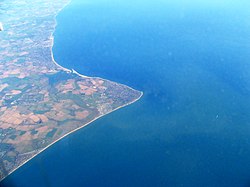Selsey
| Selsey | |
| Sussex | |
|---|---|
 Windmill on the sea at Selsey | |
| Location | |
| Grid reference: | SZ8592 |
| Location: | 50°43’22"N, -0°47’17"W |
| Data | |
| Post town: | Chichester |
| Postcode: | PO20 |
| Dialling code: | 01243 |
| Local Government | |
| Council: | Chichester |
| Parliamentary constituency: |
Chichester |
| Website: | http://www.selseytowncouncil.gov.uk/ |
Selsey is a town on Selsey Bill, a headland on the south coast of Sussex jutting into the English Channel. Selsey Bill is Sussex's southernmost point and indeed the southernmost point of Great Britain anywhere east of Tor Bay, Devonshire, and consequently Selsey is the southernmost town east of Brixham.
The town's name is Old English, meaning "Seal's Island".
The place name Selsey-Bill has become synonymous with the town of Selsey, for example Edward Heron-Allen wrote about The Parish Church of St Peter on Selsey Bill Sussex even though the church is situated in Selsey High Street.[1]
History
There have been many wrecks off Selsey Bill over the years. King Henry VI granted that lands of Chichester Cathedral should be exempt from the Court of the Admiralty in the manner of wrecks, this meant in effect that any wrecks off Selsey Bill would be the bishops property.
In the 18th century members of the Hawkhurst Gang, a notorious smuggling gang were captured and tried for the brutal murder of a supposed informant and a customs official, Chater and Galley.[2] Seven were condemned to death at the assizes held at Chichester in 1749. After they had been executed at the Broyle, Chichester, two of them were subsequently hung in chains at Selsey Bill, a Yeakel and Gardner map has a Gibbet Field marked on it where it is believed the smugglers hung.[2]
Since 1861 there has been a lifeboat station to the east of Selsey Bill, and there are a system of beacons that warn sailors of the treacherous Owers and Mixon rocks that are south of Selsey Bill.
Parish Church

The parish church is St Peter's.
Selsey Bill and the sea

In the 19th and early 20th century the local fishermen jointly owned a longboat, operated by 22 oarsmen. If any vessel were stranded off the Bill then after any rescue work had been completed the pilot of the longboat would negotiate with the skipper, of the damaged vessel, a price to assist them to safe harbour.
Notes
References
- Armstrong, J.R. (1961). A History of Sussex. Chichester, Sussex: Philimore. ISBN 08503318544.
- Bede Venerablis; translated by Leo Sherley-Price (1988). A History of the English Church and People. Penguin Classics. ISBN 0-14-044042-9.
- Cunliffe, Tom (2000). The Shell Channel Pilot, The South Coast of England and North Coast of France 3rd Edition. Cambridgeshire: Imray. ISBN 0 85288421.
- Heron-Allen, Edward (1943). The Parish Church of St Peter on Selsey Bill Sussex 2nd Edition. Chichester: Moore and Tillyer. - booklet produced by the author(1st Edition 1935) for visitors to St Peters church.
- Heron-Allen, Edward (1911). Selsey Historic and Prehistoric. Duckworth. - including 1778 map of Selsey with annotatation by the Rev Cavis-Brown in 1906.
- "Manhood Archaeology". Manhood Partnership. http://www.peninsulapartnership.org.uk/where-is-the-manhood/history-culture/. Retrieved 26 July 2010.
- Mee, Frances (1988). A History of Selsey. Chichester, Sussex: Philimore. ISBN 0850336724.
- Pennant, Thomas (1801). A journey from London to the Isle of Wight, Volume II. London: Edward Harding.